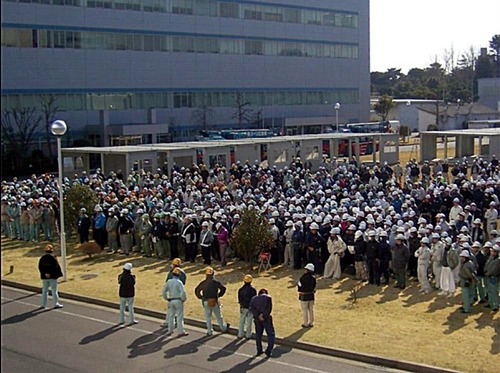Jun 4 2013
Enterprise Ireland and Lean | Irish Times
See on Scoop.it – lean manufacturing
“The Japanese are renowned worldwide for their car production where the concept of the management philosophy Lean derives from. It all began at Toyota when the car manufacturers discovered a new, more efficient method of producing cars valued by customers all over the world. The principles learned at Toyota became known as Lean which is claimed can be applied to almost any business. The core principle is creating value by reducing waste and unnecessary risk.”
While informing us that the Irish government has an agency promoting Lean, this article reflects common misconceptions.
No, it’s not a “Japanese management philosophy.” it is an approach developed by individuals who happened to be Japanese, which is not the same. Most Japanese today do not know or practice it, and quite a few non-Japanese do.
And this emphasis on “creating value” is an American talking point, not the Toyota Production System.
According to the article “Toyota benchmark themselves constantly,” which is news to me. While it is clear that Toyota is on the lookout for new ideas, I had not heard of Toyota doing benchmarking surveys of competitors. My understanding is that Toyota’s management considers such surveys to be a waste of time.
The article equates Lean with Continuous Improvement, giving the impression that it’s all there is to it.
And finally, the article repeats the Business Week claim that the Shingo Prize is “the Nobel Prize for operational excellence.”
See on www.irishtimes.com



Jun 7 2013
Can’t Always Believe Somebody Saying “Toyota Would Tell You To…” | Mark Graban
See on Scoop.it – lean manufacturing
Mark Graban on LeanBlog: “From my experience, you have to be cautious when somebody says either, “Lean says you should….” or “Toyota would tell you to…” because those statements, even if stated authoritatively, can be wrong.
At a recent speaking engagement (I won’t disclose where), a professor (one who teaches about Lean) made a curious comment that I’d put in the Lean As Misguidedly Explained (orL.A.M.E.) category.
The professor made a point that, when working in healthcare, we have to be careful about applying all methods and tools from Toyota. I agreed with that part of his statement. We’re not literally hanging “andon cords” or putting tape around every piece of equipment just because a factory does it. We have to be solving hospital problems and not just copying tools. I get that.
His example, though, was a bit off base.
The prof talked about “takt time” (or the rate of customer demand) and how we balance the service or production time to match up with takt. Again, that’s correct.
In his hypothetical, he said let’s assume that a doctor’s office is supposed to be seeing a patient every 20 minutes. What if the patient has been in the room for 19:59 already.
The prof said, ‘Toyota would tell you to kick the patient out of the room at 19:59 because you have to keep on takt time.'”
The example is about the hypothetical application of the concept of takt time to a doctor’s office. Mark’s post rebuts a statement that it would imply kicking out a patient at the end of the allotted time regardless of whether the patient’s problem was solved.
This is actually what psychiatrists do when they tell patients “Your 50 minutes are up.” But that is because these patients would otherwise linger on indefinitely. At the opposite end of the spectrum, a general practitioner I know who is an excellent diagnostician once explained that she knew what was wrong with 90% of her patients almost the second they walked into her office, and could confirm it within minutes but stayed longer with each patient just so that they would feel cared for and would trust her diagnosis.
In general, however, I don’t see the concept of takt time as applicable in situations where the work content of transactions varies in a way that cannot be anticipated. An MD can’t know how much time a patient will need. Likewise, a maintenance technician cannot know how a long a work order will require, even in preventive maintenance, because you can’t know exactly what you will find when you open a machine.
Incidentally, takt time is not “the rate of customer demand,” first because it is a time and not a rate, and second, because it is not only a function of demand but also of work time available. It is the time that must elapse between two consecutive unit completions at every operation in order to meet demand within the net available work time. It takes 26 words rather than 5, but the definition really cannot be simplified further.
It is an extremely useful concept to plan repetitive sequences of operations done by different people and machines during a shift. But I don’t see much value in applying it, for example, to people who are on call 24×7 to respond to emergencies, particularly when they do it individually. An MD in an office treats a patient end-to-end; it is in not similar to an assembly line, even if patients sometimes feel that way.
There are other approaches to managing such situations. For example, a takt-based approach to computer networks called “token ring” had its day 30 years ago. A token was passed around between computers in a loop at fixed intervals, and only the computer that had the token was allowed to speak while the others listened.
This takt-based approach was abandoned and superseded by Ethernet, in which computers essentially “grab the mike” whenever they have something to say, with a protocol to resolve confilcts when two or more speak at once. It was a better fit to the way computers communicated and is still the basis for your local office or home network today.
See on www.leanblog.org
Share this:
Like this:
By Michel Baudin • Blog clippings 2 • Tags: Doctor of Medicine, Ethernet, Lean manufacturing, Maintenance, Patient, Toyota